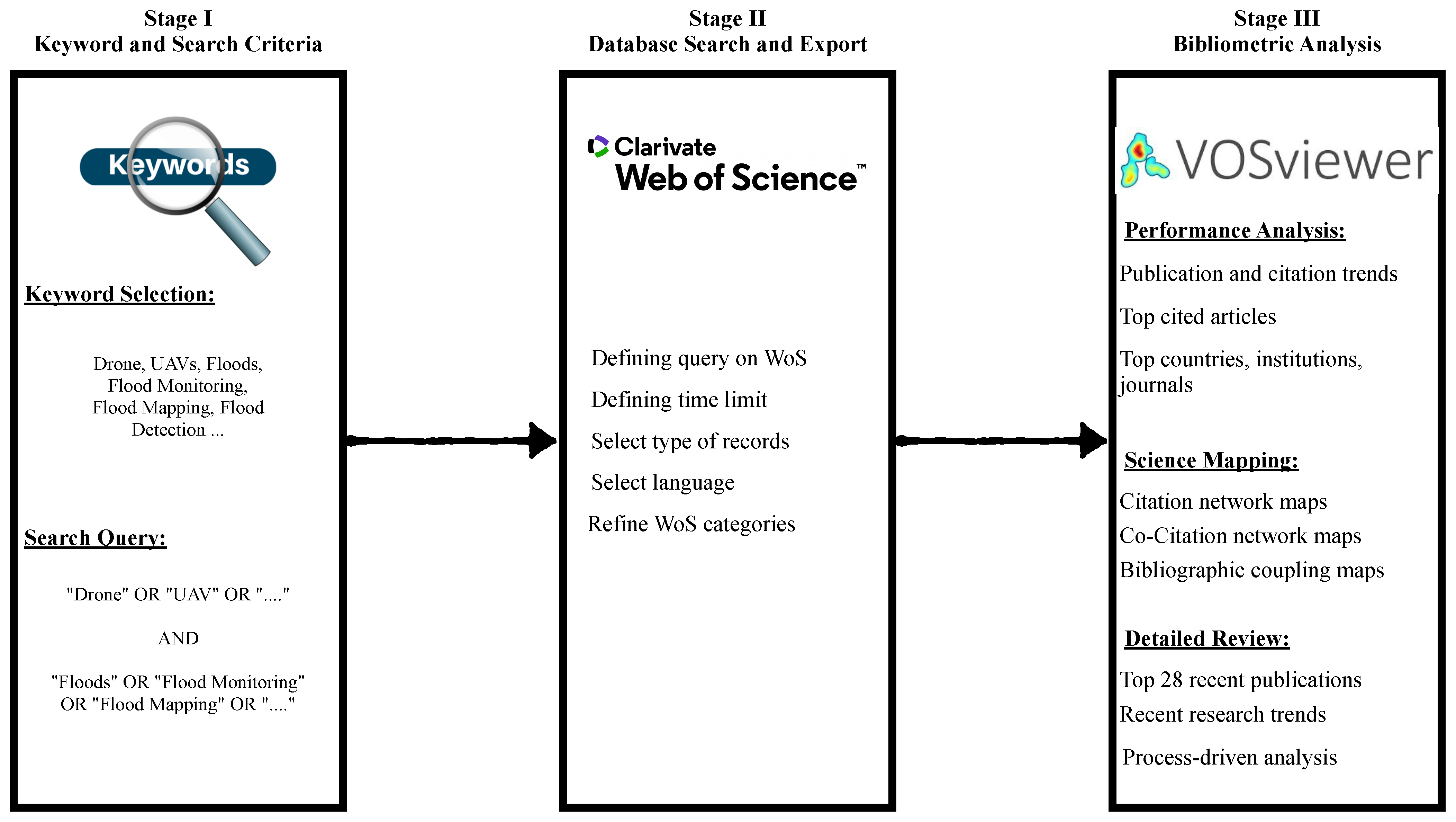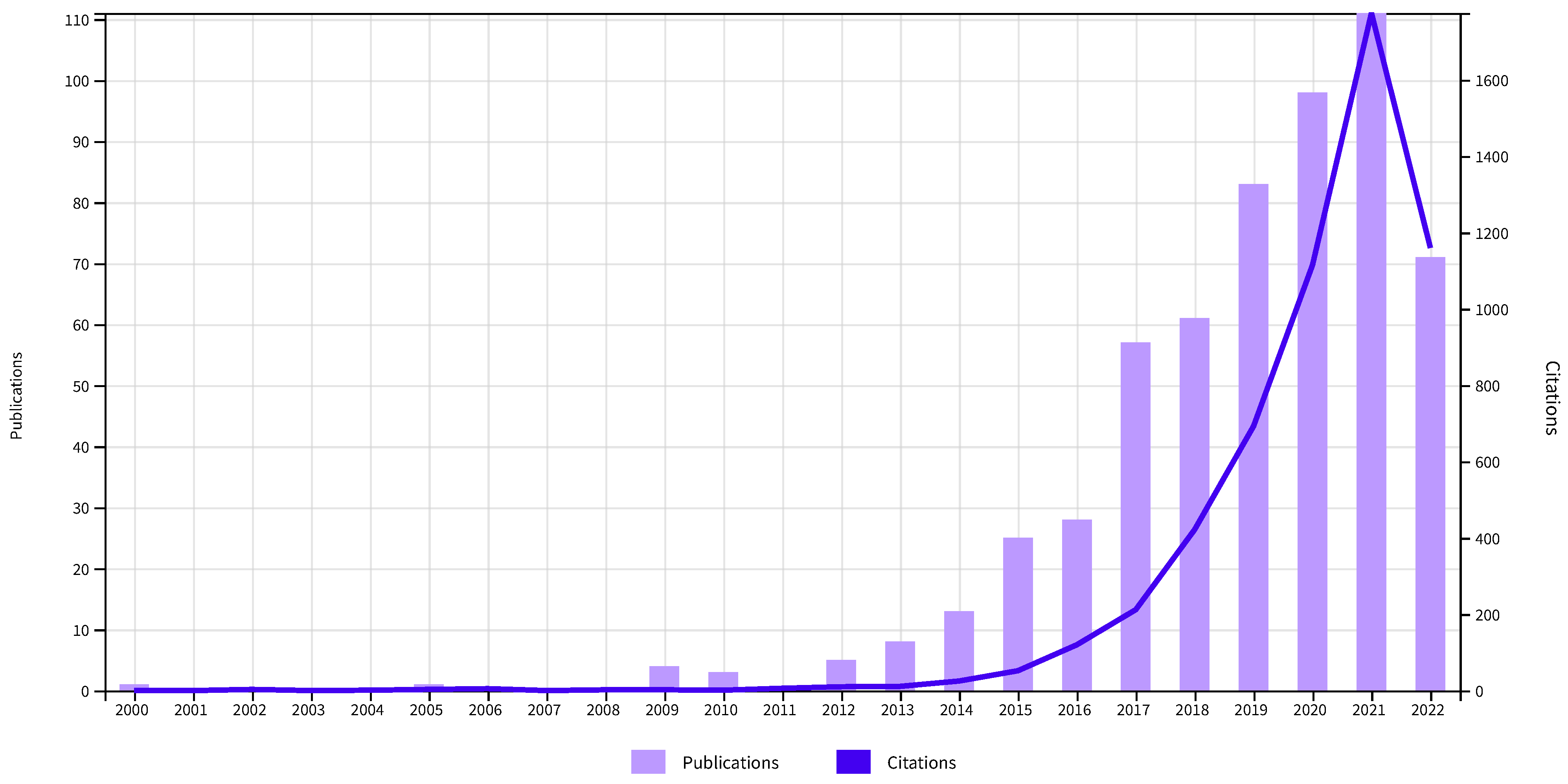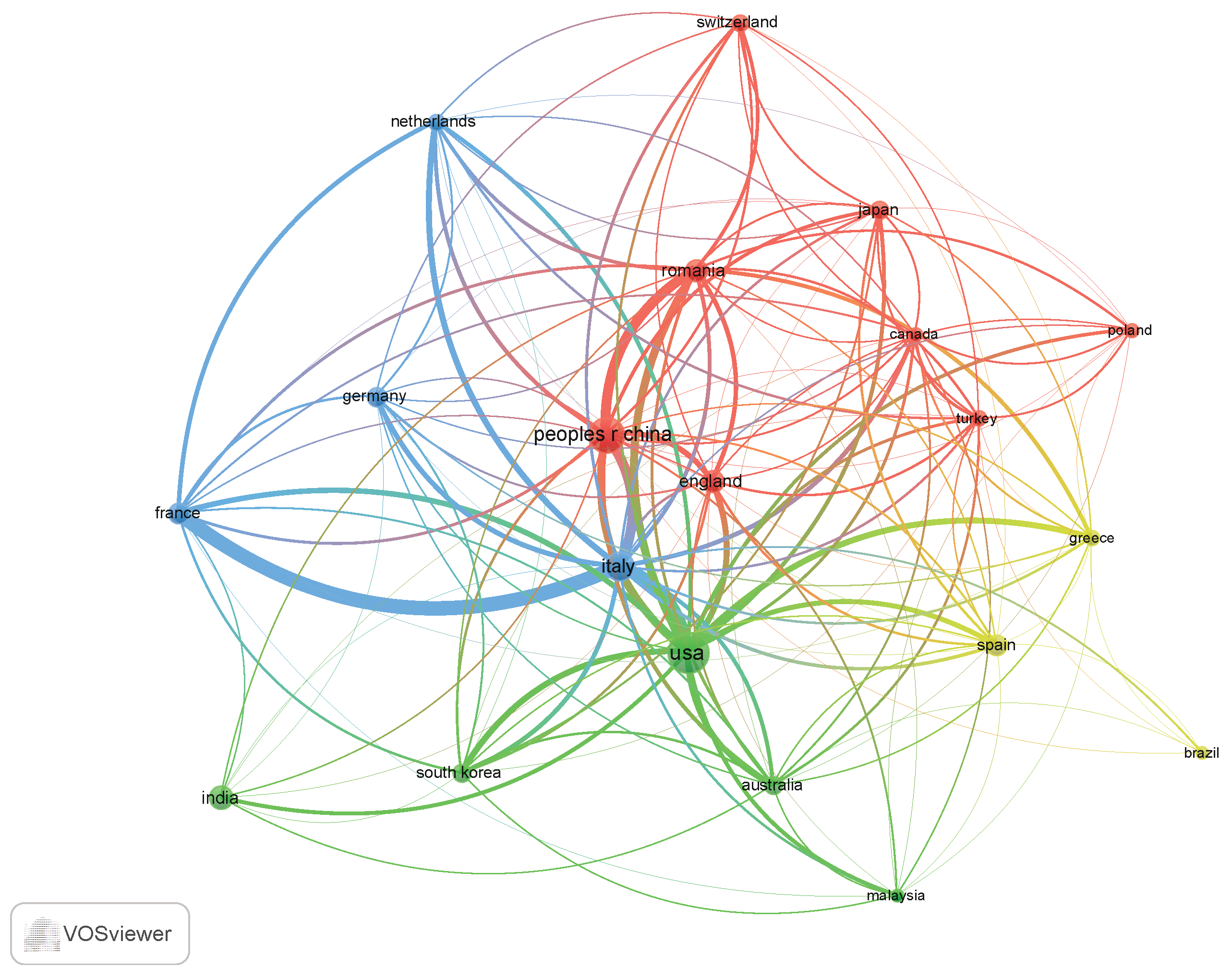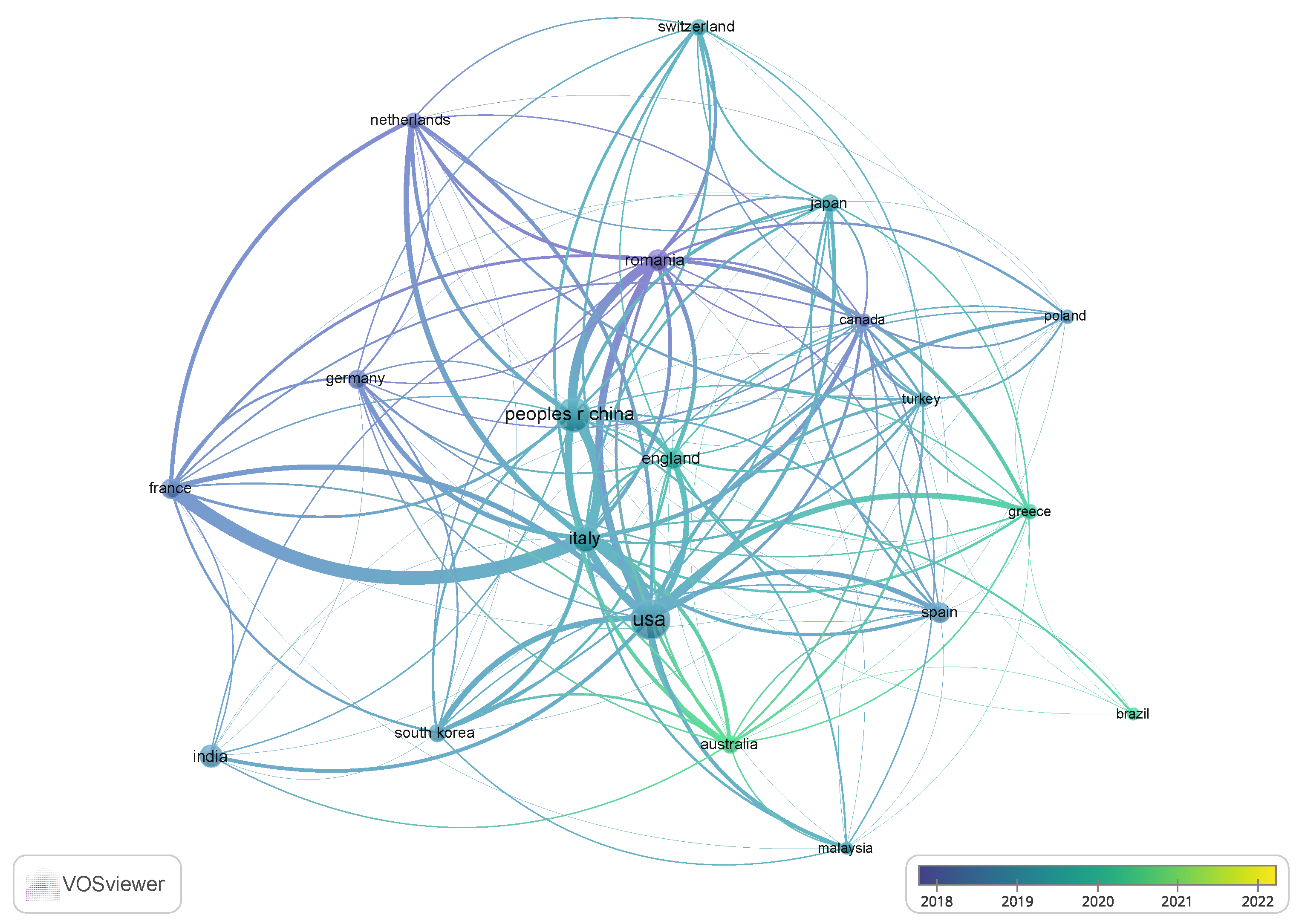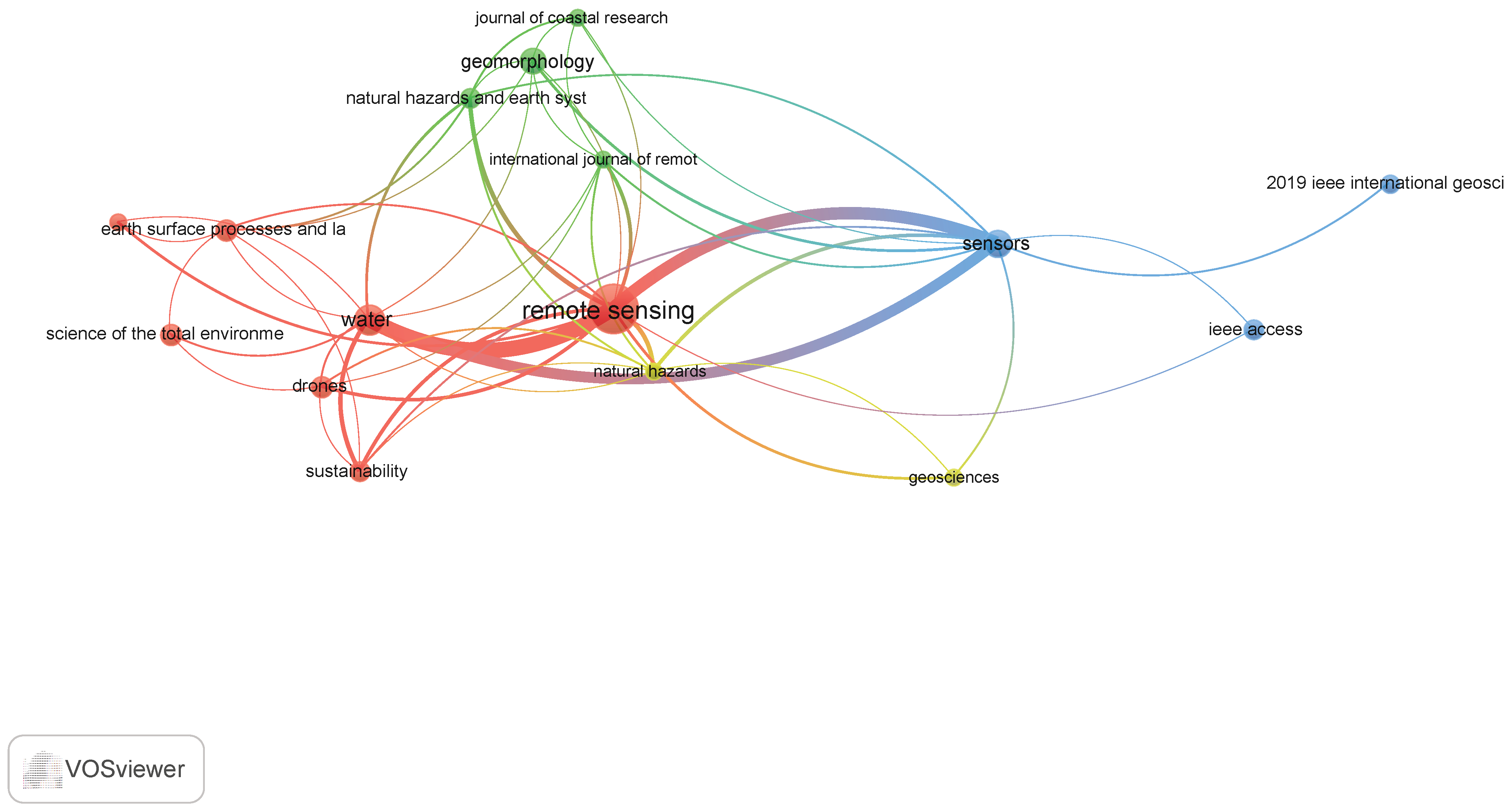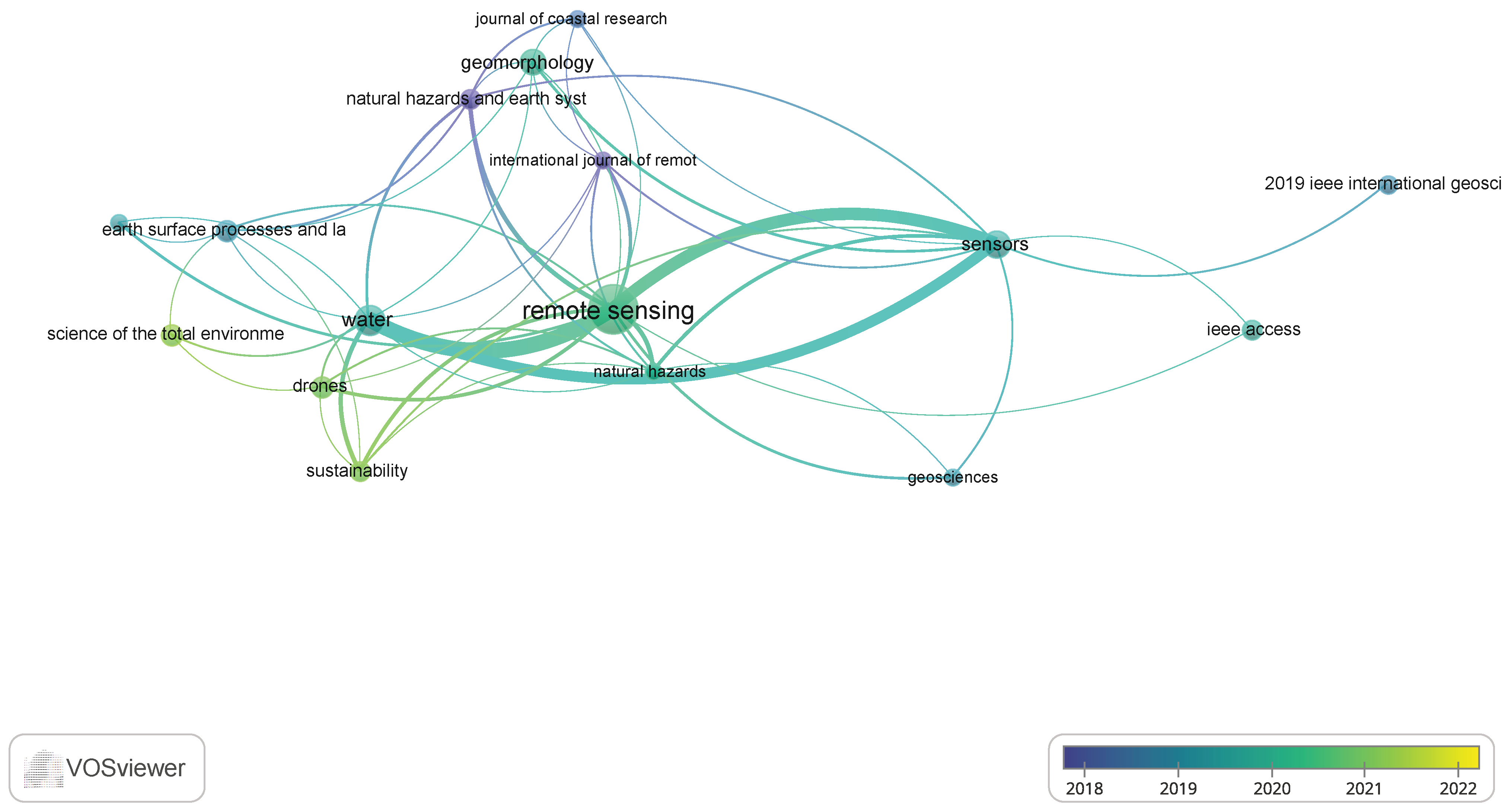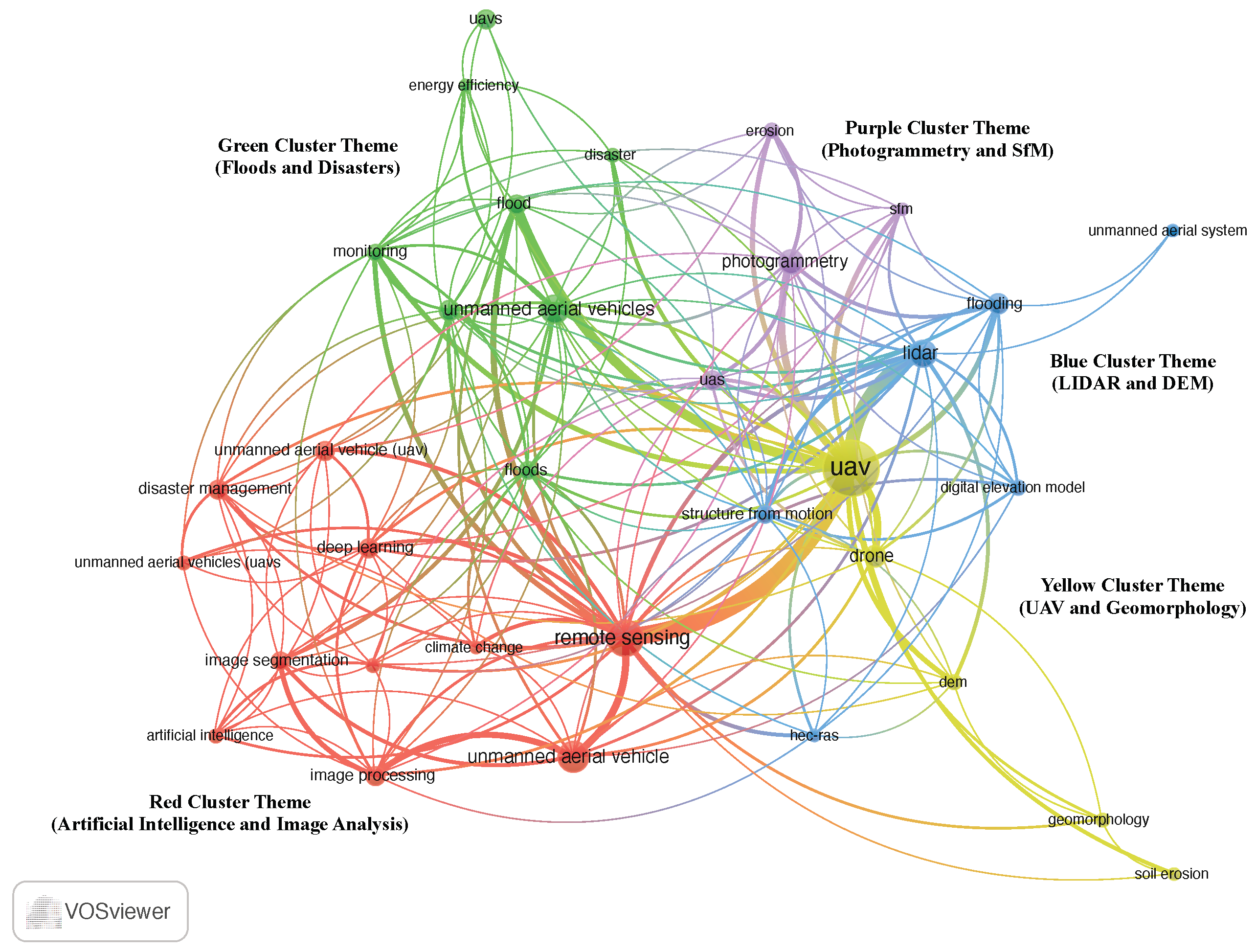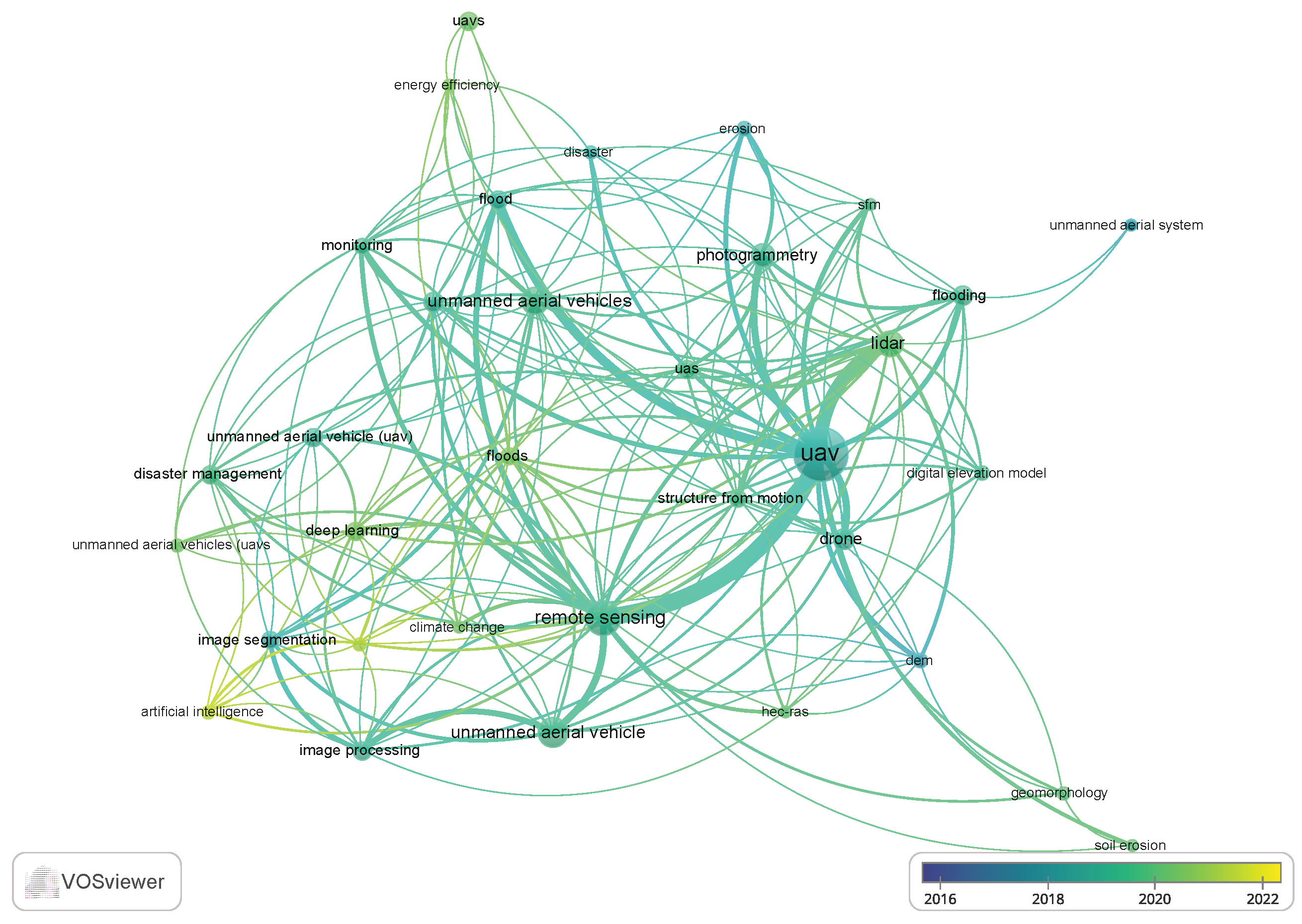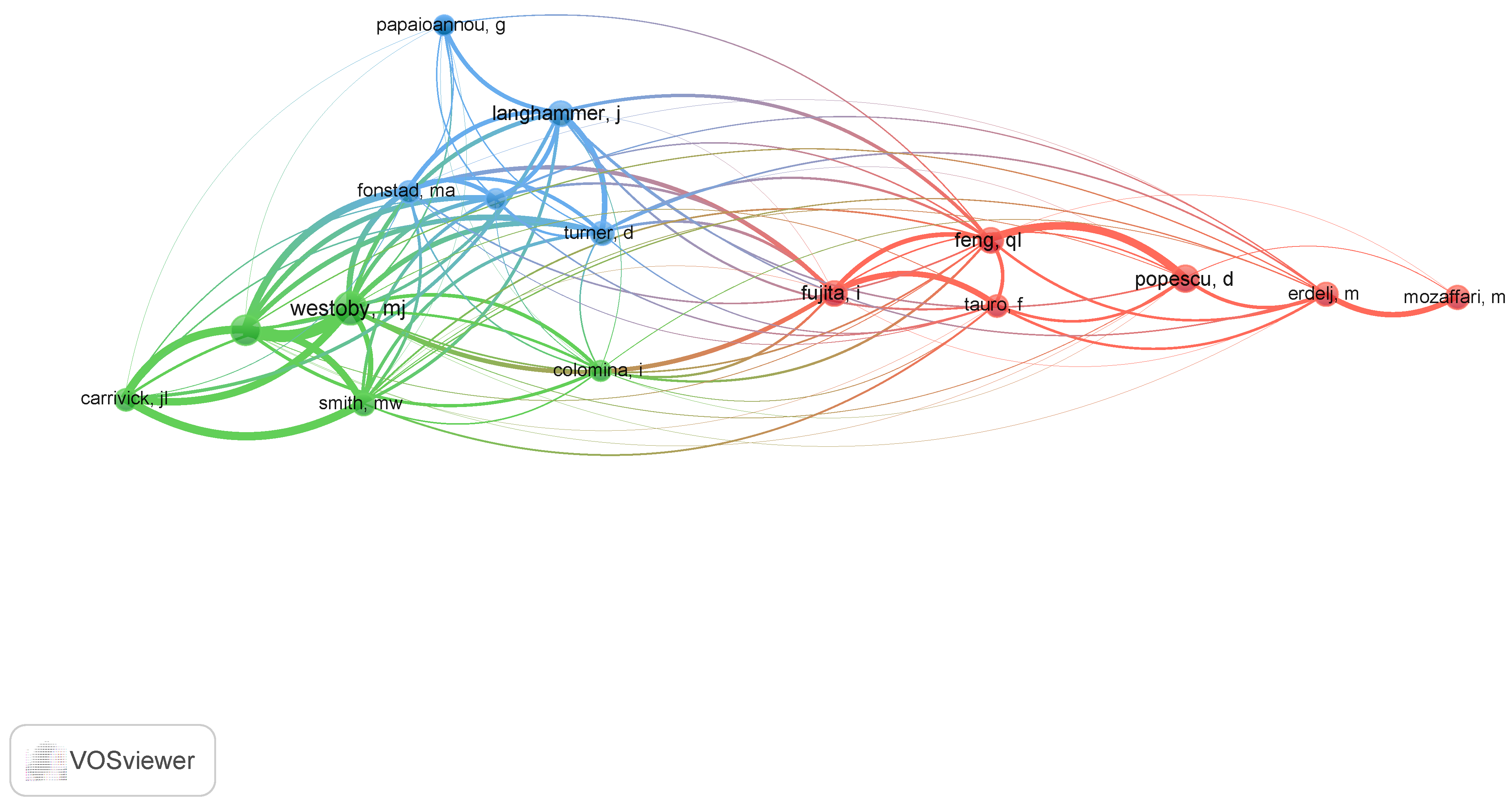1. Introduction
Floods are among the most devastating and frequently occurring natural hazards, mainly because of the associated damages and mass-scale community impacts [
1,
2,
3]. Some highlighted damages caused by flooding include structural damage, agricultural damage, relocation of communities and loss of human life [
4,
5]. The recent increase in flooding events is often attributed to climate change and global warming causing intense and prolonged rainfalls [
1,
6]. However, the increased damages due to flooding events are associated with human-induced factors, such as exponential population growth, unplanned urbanization and inefficient flood management [
7,
8]. Among the above-mentioned factors, efficient flood management is considered significant in reducing the impacts of floods. Towards improving the existing flood-management mechanisms, it has become inevitable to benefit from the latest technological advancements.
Drones, also known as unmanned aerial vehicles (UAVs), are increasingly being used in a variety of scientific domains to collect data and perform tasks that would be difficult or impossible for humans to do [
9,
10,
11]. Drones have applications in multiple scientific domains, such as agriculture (e.g., crops monitoring [
12], detecting diseases [
13], mapping fields for optimized fertilization and irrigation [
14,
15]), environmental science (e.g., wildlife monitoring [
16,
17], forest health assessment [
18], water quality monitoring [
19], air quality monitoring [
20]), oceanography (e.g., marine life monitoring [
21], monitoring of ocean currents and tides [
22]), archaeology (e.g., detailed site mapping [
23], hidden structure identification [
24]) and disaster response (e.g., damage assessments [
25], victim identification [
26], boundary identification [
27], quick extent mapping [
28]). In the context of flood management, drones are reported to be one of the technology-oriented platforms which could significantly assist many activities, specifically monitoring, mapping and detection [
1,
9,
29]. In the recent past, drone technology has exponentially progressed with the availability of efficient sensing hardware, commercialization and ease of access. A small-to-medium drone fully equipped with advanced sensors (e.g., camera, Light Detection and Ranging (LiDAR), infrared (IR) heat sensor), edge-computing hardware (e.g., NVIDIA) and state-of-the-art artificial intelligence (AI) algorithms can serve as an efficient tool to assist monitoring, mapping and detection for flood-management activities. A few highlighted flood-management activities that may benefit from drone technology include flood inundation mapping [
30,
31], flood-damage mapping [
31,
32], surface-water detection [
19,
33], flood-boundary identification [
34,
35] and flood-victim identification [
36]. Overall, drones have proven to be an efficient on-demand tool with the advantages of low cost, high safety and robustness from a flood-management perspective [
9]. However, the flood-management domain is yet to explore the full potential of drone technology; therefore, this domain presents a huge opportunity for future research.
According to its definition, the branch of study known as “bibliometrics” involves scholars analysing bibliographic records (i.e., published literature) using various statistical and mathematical techniques in order to spot significant trends and patterns [
37,
38,
39,
40]. Bibliometric studies are a type of research that uses quantitative methods to analyse and measure the impact and influence of publications. These studies typically aim to identify patterns and trends in the production, distribution and reception of knowledge, and to evaluate the relative importance and impact of different bibliographic factors (e.g., citations, authors, institutions, journals) [
37,
38]. One of the key aims of bibliometric studies is to provide a systematic and objective assessment of the state of a particular field of research. This is achieved by measuring the quantity and quality of relevant publications, and the extent to which they are cited and used by other scholars. This can help researchers, policy makers and funding agencies to identify areas of strength and weakness, and to make informed decisions about the allocation of resources and support. Another aim of bibliometric studies is to identify emerging trends and areas of growth in a field, by analyzing the changing patterns of publication and citation over time. This can help researchers to identify new opportunities and challenges, and to stay up-to-date with the latest developments in their field. Bibliometric studies can also be used to assess the impact and reach of individual publications, authors and institutions, by measuring the number of citations they receive, the journals in which they are published and the countries and institutions where they are cited. This can help researchers to evaluate their own work and to identify opportunities for collaboration and networking with other scholars [
39,
40]. Further, organizations can utilize this type of analysis to make decisions and evaluate the effectiveness of particular institutions, countries and periodicals. The VOSviewer [
41], BibExcel [
42], CiteSpace [
43] and Bibliometrix [
44] are some of the highlighted software tools used by the researchers to perform the bibliometric analysis. Drones have been identified as one of the trending technologies being utilized for flood monitoring and detection due to their capacity to provide an on-demand, larger perspective of the flooded region and map the degree of damage. The performed bibliometric analysis will facilitate the workers dealing with flood management and drone technologies in acquiring the important quantitative trends. Additionally, new researchers will benefit from identifying focal research areas and potential research directions. These evaluations can also help funding agencies identify possible institutions and locations where research in this topic should be fostered. Motivated by the significance and necessity of such an analysis, this work presents a comprehensive bibliometric review of the literature concerning the use of drone technology for flood monitoring, mapping and detection.
The main objective of the performed bibliometric analysis is to highlight and understand the significant research trends in the context of using of drones for flood monitoring, mapping and detection activities. To achieve this objective, this paper presents performance analysis (i.e., publication statistics, citations statistics, top publishing countries, top publishing journals, top publishing institutions, top publishers, top Web of Science (WoS) categories) and science mapping (i.e., citations by country, citations by journals, keyword co-occurrences, co-authorship, co-citations, bibliographic coupling) for relevant bibliographic records extracted from the WoS database. The article is organized as follows:
Section 2 provides the information about the research approach, materials and methods used to conduct the bibliometric analysis.
Section 3 is the core of this manuscript, which presents the detailed bibliometric analysis in terms of performance analysis and science mapping.
Section 4 outlines the important insights that emerged from the bibliometric analysis and includes the subjective discussions on the results.
Section 5 presents the process-driven review of recent literature to evaluate the research in line with the flood-management activities. Finally,
Section 6 concludes the study and summarizes the outcomes of the study. Furthermore, potential limitations and future research directions are also highlighted.
5. Recent Research Trends
This section presents a detailed author-centered review of 28 recent literature entries that utilize drones to address flood-management issues. The aim of this review is to highlight the current trends in this research domain and identify active areas of research where the potential of drones is being explored in the context of flood management. In order to provide a comprehensive understanding of the research in this field, the review is organized chronologically to demonstrate the evolution of technology in this domain. Additionally, a process-driven review of the literature is included to analyze the research from the perspective of flood-management utilities. This review aims to provide a nuanced understanding of the current state of research in the field of drone-based flood management and identify areas for future study.
Akay et al. [
69] used UAV-based monitoring to quantify and visualize the morphological changes of meander structures in the Buyuk Menderes River Basin in Turkey. Field surveys were conducted in 2018 and 2019, and multi-temporal orthomosaics and digital surface models were constructed using the SfM technique. The digital shoreline analysis system and DEM of difference tools were used to assess spatial and volumetric changes in the meander structures. The results of this study highlight the importance of mapping and monitoring river basins for effective disaster management. Loli et al. [
70] described a study that used drones and 3D modeling to investigate a flash flood that caused damage to bridges and buildings in Central Greece. The research focused on a single case study and used detailed mechanical modeling to investigate the failure of a bridge abutment during the flood. The study found that the flood had a lower bound-flow velocity at the subject location, and suggested that this approach could be used to estimate the intensity of similar extreme events in the future. However, the study only focused on a single case and did not provide a detailed comparison with other methods for studying flash floods. Ye et al. [
71] proposed a novel approach using drones to improve the quality of drainage-network extraction in flat terrains. The approach uses information about hydrogeomorphic features, such as obstacles and channels, to construct a digital elevation-extended model (DXM), which is then used to extract drainage networks. The approach was applied and validated in a case study in Yanhu Lake, and was found to be effective at determining flow directions. The use of drones in the approach allows for high-resolution data collection, which improves the accuracy of the extracted drainage networks. However, it is not clear from the text how this approach compares to existing methods for drainage network extraction, or how it might be applied in practice. Additionally, the use of a priori knowledge about hydrogeomorphic features raises questions about the generalizability of the approach to other areas.
Su et al. [
72] performed an investigation that used drones equipped with visible and infrared cameras to detect leakage in river embankments during flood season. The study proposed a leakage identification method based on UAV infrared images and a region segmentation method based on infrared and visible image fusion. The proposed methods were applied to an actual river embankment and found to be effective at identifying leakage. Our study suggests that this approach has potential for use in detecting leakage in river embankments during flood season. Kundu et al. [
73] estimated the extent and depth of floodwater in the Houston area after Hurricane Harvey using data from LiDAR DEM and synthetic aperture radar (SAR) and unmanned aerial vehicle synthetic aperture radar (UAVSAR). The flood’s extent was observed to decrease between 29 and 30 August and 5 September 2017, and the flood depths estimated using DEM were compared with USGS gauge data and showed a high correlation. The use of Sentinel-1 and UAVSAR allowed for daily temporal repeat and provided detailed information on the affected areas for disaster management. Trepekli et al. [
74] examined the potential use of miniaturized LiDAR scanners mounted on UAVs for improving urban flood modeling and assessments at the local scale. By generating ultra-high-spatial-resolution digital terrain models featuring buildings and urban microtopographic structures, the accuracy and detail of simulated flooded areas were vastly improved. The use of UAV-LiDAR data enabled the identification of structures such as archways and bridges that were critical for predicting precise run-off courses. The application of UAV-LiDAR technology may enhance the effectiveness of urban planning by projecting the locations, extents and run-offs of flooded areas in dynamic urban settings.
Khan et al. [
75] highlighted the potential for using UAVs in disaster management. UAVs can provide fast, cost-effective, easy-to-deploy and secure wireless communication to victims after natural or human-made disasters, such as floods, earthquakes and tsunamis. The study also discusses the potential challenges and issues associated with using UAVs in disaster management, including interference; coordination; quality of service (QoS) requirements; and size, weight and power limitations. Overall, the use of UAVs in disaster management can provide an effective and efficient solution for providing communication and support to victims in the aftermath of disasters. Papaioannou et al. [
76] investigated the use of UAVs to generate high-resolution orthophoto mosaics and DEMs to create spatially distributed roughness coefficient maps. The maps were used to improve flood inundation modeling in ungauged streams. The study found that a combination of local entropy values and maximum likelihood classification produced satisfactory results in determining grain classes along a stream with inhomogeneous bed composition. The resulting roughness coefficient maps were used in 1D, 2D and coupled (1D/2D) hydraulic modeling approaches for flood inundation modeling. The methodology was demonstrated on the Xerias stream in Greece and could potentially be applied to other Mediterranean streams with similar characteristics. Song et al. [
77] used UAVs to monitor and assess flood risks in urban areas. The UAVs were used to create high-resolution topographic data, which were then used to conduct a watershed analysis to identify points of convergence for rainwater flow. Based on this analysis, a monitoring point was proposed for preventing flood damage in the area. The study demonstrated the potential of UAVs for improving flood-risk assessments and informing flood prevention efforts in urban areas.
Alfonso-Torreno et al. [
78] analyzed the effects of gully control measures on the hydrological dynamics and sediment load in an agroforestry system in southwestern Spain. The control measures included gabion check-dams, brushwood check-dams and fencing, and were implemented and monitored using aerial images acquired by an UAV. The results showed that the control measures reduced suspended sediment concentration by 65% and successfully stabilized the expansion of the channel network. The study highlights the potential for UAVs to be used in monitoring gully rehabilitation efforts. Further research is needed to understand the long-term effects of the control measures. Higgisson et al. [
79] used UAVs and convolutional neural networks (CNNs) to estimate the cover of
Phragmites australis, a type of reed, in a wetland in Australia. The study found that prior environmental watering significantly increased the cover of
Phragmites australis and improved the condition of the reedbeds. The use of UAVs and CNNs allowed for consistent data collection and analysis in difficult-to-access areas. These findings demonstrate the potential for using environmental water to maintain the resilience of wetlands. Yang et al. [
80] proposed the use of drones and remote-sensing techniques, such as LiDAR and UAV surveys, to study the effects of a rainfall-induced landslide at Mt. Silabaku in Taiwan. The analysis of the data revealed that the landslide was caused by heavy rains and local failures, resulting in large deposits of debris along the Yusui Stream. The high-resolution topographic data showed that the debris deposits were estimated to be over 8 million cubic meters, posing a threat to nearby villages and infrastructure. This study highlights the importance of using drone technology and remote sensing for disaster management and risk assessment in landslide-prone areas.
Alberico et al. [
81] used satellite and drone images to monitor the formation and dismantling of a fan delta at the mouth of the Sfalassa Stream in Calabria, Italy. The flood event of November 2015 placed 25,000 m
3 of coarse sand and gravel sediments in a few hours, forming the fan-shaped delta. The delta was then dismantled by three main storm surges occurring from November 2015 to January 2016. The images showed the gradual erosion of the fan delta, highlighting its complete dismantling in about three months. This analysis demonstrated the usefulness of high-resolution observing systems in understanding the processes that shape coastal environments and in informing coastal-zone-management efforts. Jiang et al. [
82] examined the vegetation of the reservoir Water Level Fluctuation Zone (WLFZ) in the Jinsha River basin in China using small UAVs and field research. The study found that the original drought-tolerant vegetation in the WLFZ has evolved into amphibious herbaceous vegetation, with simpler species composition and a lack of trees and shrubs. The results also showed that flooding stress has a greater impact on vegetation species than drought stress, and that vegetation in the WLFZ is distributed in a band-like pattern along the water-level elevation gradient. The authors suggest that the restoration of the WLFZ should prioritize native species and take local conditions into account. Prabhu et al. [
83] proposed the use of deep learning techniques and UAVs for identifying and locating survivors in flood-devastated areas during rescue operations. The proposed model, called RescueNet, uses UAV images to detect and count affected individuals in real-time. Results show that the model has high precision, high recall and a high F1-score, indicating its effectiveness in aiding rescue efforts.
Hernandez et al. [
84] proposed an AI-based pipeline for processing natural disaster images taken by drones. The pipeline, which consists of a lightweight autoencoder, dimensionality reduction and fuzzy clustering, is designed to reduce the amount of information to be processed by first responders in the event of a natural disaster. The proposed pipeline was evaluated on several edge computing platforms with low-power accelerators and was shown to substantially reduce the amount of information to be processed while providing real-time tracking of natural disasters. This demonstrates the potential for using drones and AI in disaster responses. Munawar et al. [
27] proposed a design for maximizing drone coverage in a post-disaster flood situation. A mathematical optimization model was developed, and the Particle Swarm Optimization (PSO) algorithm was used to solve the problem. The proposed approach indicates that maintaining the flight height of the drone above 120 m can enhance coverage by approximately 34% compared to a flight height of 100 m. This study highlights the potential for using drones in disaster response and recovery efforts. Bilasco et al. [
85] presented a hybrid risk-assessment methodology for buildings in cases of floods using geographic information systems (GIS) and UAVs to collect and process data. The methodology is based on detailed information on the terrestrial surface and measurements of past flood levels to estimate post-flood peak discharge. This information is used to calculate shear stress and velocity, which are then used to create a hazard and risk map for buildings. The study highlights the potential for using GIS and UAVs in strategic flood management, and the value of involving citizens in mapping risks and adapting to climate change.
Romagnoli et al. [
86] performed a study on Lipari island in the Aeolian Archipelago and examined the coastal erosion and flooding in the low-lying areas of the island, which are particularly vulnerable to the effects of sea-level rise. The study used remote-sensing techniques such as aero-photogrammetry, UAV surveys and satellite data, and offshore geophysical surveys and field observations. The results showed that natural and anthropogenic factors played a role in the long- and mid-term evolution of the studied coastal areas, and highlighted the need for proper management to reduce natural risks and mitigate the impacts of future climate change. Guo et al. [
87] combined the use of ground penetrating radar (GPR) with UAV detection to study the recent sediments of a braided river in Datong, China. The GPR technique was used to describe the fluvial facies and reservoir architecture of the area, and the data were processed and interpreted to identify the characteristics of different sedimentary units. The results show that GPR and UAV data can be effectively combined to study the complex spatial distributions and internal structures of braided river reservoirs, which has important implications for flood mitigation, among other things. Hagge-Kubat et al. [
88] investigated a hillslope debris flow that occurred in the Eifel area of western Central Europe using a combination of field studies and geophysical techniques, including electrical resistivity tomography, direct push hydraulic profiling, sediment coring and UAV-generated photogrammetry. The results showed that the geomorphological and geotectonic position of the hillslope played a crucial role in the triggering of the debris flow. The combination of large surface runoff and strong interflow at the sliding surface caused the transformation from an initial translational slide into a hillslope debris flow. The study also developed and validated a stand-alone model of the debris flow on a local scale, which showed promising results. This research highlights the potential for using drones in the investigation of mass movements in mountain regions.
Wang et al. [
89] proposed a new method for monitoring ice velocity in rivers using UAVs and machine vision technology. The method involves using UAVs to capture high-resolution orthoimages during ice flood periods, extracting feature points in drift ice images with the scale-invariant feature transform algorithm and tracking the motion trajectories of these points to establish an ice displacement rate field. The study demonstrated the effectiveness of this method by applying it to the Mohe River in Heilongjiang Province, China, and finding average ice velocities of 2.00 and 0.74 m/s. This method offers a cost-efficient and accurate alternative to traditional ice-velocity-monitoring methods. Lei et al. [
90] proposed a new method for monitoring and assessing flood disasters using a combination of satellite remote sensing, UAV remote sensing and field measurements. The method was tested in Poyang County, Jiangxi Province, China, and was able to accurately assess the extent of the flood, and provided information on the evolution of the disaster and its impact. This integrated air–space–ground approach can provide detailed information at different spatiotemporal scales, supporting emergency responses and disaster reduction efforts. Giulietti et al. [
91] proposed a method for water-level evaluation using photogrammetry derived from images recorded by UAVs. The dense point cloud was used to find the best fitting plane for the river water surface using the random sample consensus (RANSAC) method. A reference point of known altitude within the image was used to compute the distance between it and the fitted plane, allowing for the monitoring of the water’s surface altitude. The sensitivity of these photogrammetric techniques for river water level determination was also analyzed, with a focus on the effects of image data quality, reflections and process parameters. The optimal plane depth and number of iterations were found to have minimal error.
Giannitsopoulos et al. [
92] examined the current variability in England with regard to the use of unmanned aerial systems (UASs) in flood-emergency responses. Expert elicitation was used to gather information on UAS deployment in different flood-emergency scenarios. The survey found that reducing equipment assembly time, establishing a national network of qualified UAS pilots and effective deployment of UASs when on-site could reduce the response time to flood emergencies. In order to improve comparability and reduce bias in data collection and interpretation, clear guidelines on data products, processing time, platform and sensor selection may also be necessary. The authors suggest that releasing a comprehensive documentation pack with guidelines and protocols for UAS pilots on flood emergency calls could enhance the timeliness of responses. Amphawan et al. [
93] demonstrated the potential for using UAVs for free-space optical communications during rescue operations in flood-stricken areas. By leveraging linearly polarized Laguerre–Gaussian modes for spatial mode diversity, the bit error rate was improved by 38% to 55%, which was attributed to an increase in the predominant mode power. The results of this study highlight the potential for using UAVs in establishing efficient communication during the disaster response and recovery efforts. Belcore et al. [
94] used multispectral drone imagery to generate a high-resolution land cover map of flood-prone rural villages in southwest Niger. The resulting map was used to estimate potential damages from flood events by focusing on highly detailed classes, such as houses and production areas. The land cover was generated using object-oriented supervised classification with a random forest classifier. The study found that the resulting map had an overall accuracy of 0.94, with the least performant classes being grasslands and rocky clustered areas. This method could be useful for monitoring areas vulnerable to natural hazards and reducing disaster risk. Hidayah et al. [
95] used 2D-hydrodynamic modeling and digital surface models (DSMs) from UAV imagery to construct flood hazard maps based on hazard levels for various flood return periods. The results showed that the simulation of return periods for 2 and 10 years resulted in a 37% increase in flood hazard levels. The study also identified areas that were exposed to increased levels of flood inundation, including housing, roads and rice fields. The use of UAV imagery in this study highlights the potential for using drones in flood risk reduction efforts.
In summary, from the presented recent literature, the followings trends can be reported:
The active areas of research from the latest relevant literature include post and pre-flood structural assessments, flood risk mapping, land cover estimation, hydraulic structure monitoring, flood depth estimation, flood victims detection, flood coverage mapping, debris flow monitoring, coastal monitoring, sediment transport, floodplain and reservoir vegetation monitoring, real-time flood detection, water level measurements and emergency communication networks.
The trending technologies reported in the literature include computer vision, deep learning, SfM, LiDAR, DEM, 2D hydraulic modeling, CFD, photogrametry, SAR, CNN, YOLO, PSO, GIS, GPR and DSM.
In terms of how frequently certain technologies are used, computer vision, deep learning and DEM emerged as top three most used technologies.
Given the summary of how latest technologies are being used in the context of drone-based flood management, listed are a few use-cases demonstrating the directions in which future research may move.
Water/flood depth estimation using the latest computer vision and deep learning techniques (e.g., reference object detection-based estimation, water gauge detection-based estimation).
Flood-damage mapping of a given area using computer vision and LiDAR sensors. In addition, the use of SfM technology for 3D construction and detailed building level damage analysis.
Surface-water detection using conventional image processing techniques and deep-learning-based segmentation models.
On-demand monitoring and detection of coastal floods using UAV-captured visual and LiDAR data analyzed with latest machine learning and deep learning algorithms.
Process-Driven Analysis
The process-driven analysis of literature aims to examine and understand the technological contributions within the context of flood management. By aligning these contributions with specific phases and needs within flood management, solution providers can better understand the requirements and specific activities that their solutions should address. For example, during the response phase of flood management, there may be a need for real-time drone-based mapping solutions to quickly provide a map of flood-affected areas, even if the accuracy is not 100%. On the other hand, during the mitigation phase, a flood hazard zone mapping solution may need to be more precise, but may not necessarily need to be real-time. Understanding the specific needs and requirements of each phase of flood management is crucial for developing effective and appropriate solutions.
Table 8 presents the results of a process-driven analysis of recent literature that utilizes drones for various activities related to flood management. The analysis shows that the majority of research in this area focuses on the mitigation phase of flood management, specifically targeting needs related to flood-vulnerability monitoring and flood-risk assessment. This may be due to the fact that drones are well-suited for on-demand mapping of local areas, which can be more efficient and cost-effective than using full-scale manned aerial platforms. Additionally, many mapping solutions do not require real-time functionality, allowing for the collection and analysis of high-resolution images at a base station using advanced algorithms. While the use of drones for on-board computing using edge computers is a challenging task due to payload and power constraints, they are commonly used during the response phase for activities, such as flood monitoring, flood mapping, structural-damage assessments and flood-victim identification. During the preparedness phase, drones have been used for hydraulic structure monitoring and water-level monitoring. However, the recovery phase has been largely neglected in this regard, despite the potential for drones to assist in tasks such as reconstruction monitoring, flood-debris removal and transport-route clearance.
6. Conclusions
The manuscript reported detailed bibliometric analysis on the trends in the literature in the context of the use of drones for flood monitoring, mapping and detection. The performance analysis and science mapping were performed on a total of 569 bibliographic records exported from the Web of Science (WoS). The performance analysis suggested a rapid increase in the number of publications and corresponding citations from 2014 onwards, which may be related to the latest advancements in the drone-related technologies and the commercial availability of drones at cheap prices. The increasing trend of publications was also found to be common among other bibliometric reviews, which suggests that this may be associated with the change in academic dynamics. In terms of geographic distribution, the United States of America (USA) and Peoples Republic of China have emerged as the two countries with the highest numbers of publications. This trend may be associated with the number of recent flooding events and emphasis on disaster-mitigation policies. However, these two countries emerged on top among the bibliometric reviews on the other topics, which suggests that this trend likely to be associated with the number of universities and the rankings of the universities in these countries resulting in more publications. In terms of journals, Remote Sensing, Sensors and Water were found to be the top placed where related research was published. MDPI emerged as one of the top publishers where most recent research was published, which may be attributed to their rapid publication, high impact factors and open-access policy. The keyword co-occurrence analysis revealed UAVs, remote sensing, floods, drones, deep learning and artificial intelligence as trending terms, which suggests that drones equipped with the latest hardware sensors (e.g., camera and LiDAR) are used to capture the information, which later is analyzed using the latest computer vision algorithms to extract flood-relevant information. Furthermore, the focus of most recent research was observed to be towards development of novel computer vision and machine learning algorithms rather than purely towards drone hardware. In the bibliographic coupling and co-authorship analysis, the strongest collaboration for countries was observed to be between the USA and China, while for journals it was between Remote Sensing and Photogrammetry. These strong relationships suggest that similar research is being performed; however, it is also important to mention that benchmark research is being published by among one of these countries/journals, resulting in more coupled citations. Based on the detailed review of the 28 most-recent literature entries, flood-depth estimation using compute vision, flood-damage mapping, 3D reconstruction using structure from motion (SfM), surface-water detection and coastal flood monitoring were identified as the potential active areas of research. In the end, a process-driven analysis was performed, which indicated that most of the research is performed within the mitigation phase for addressing flood vulnerability mapping and flood-risk assessment needs. However, the recovery phase is completely being neglected despite having the potential for the use of drones in tasks such as reconstruction monitoring, debris removal monitoring and transport route monitoring. A few limitations of the performed bibliometric analysis are subjective discussions of the results, short-term forecasts only and an inability to assess the quality of the reported bibliographic records. A detailed systematic review streamlined to a more specific concept will lead into better and more detailed insights into the literature related to use of drones for flood-management activities.
